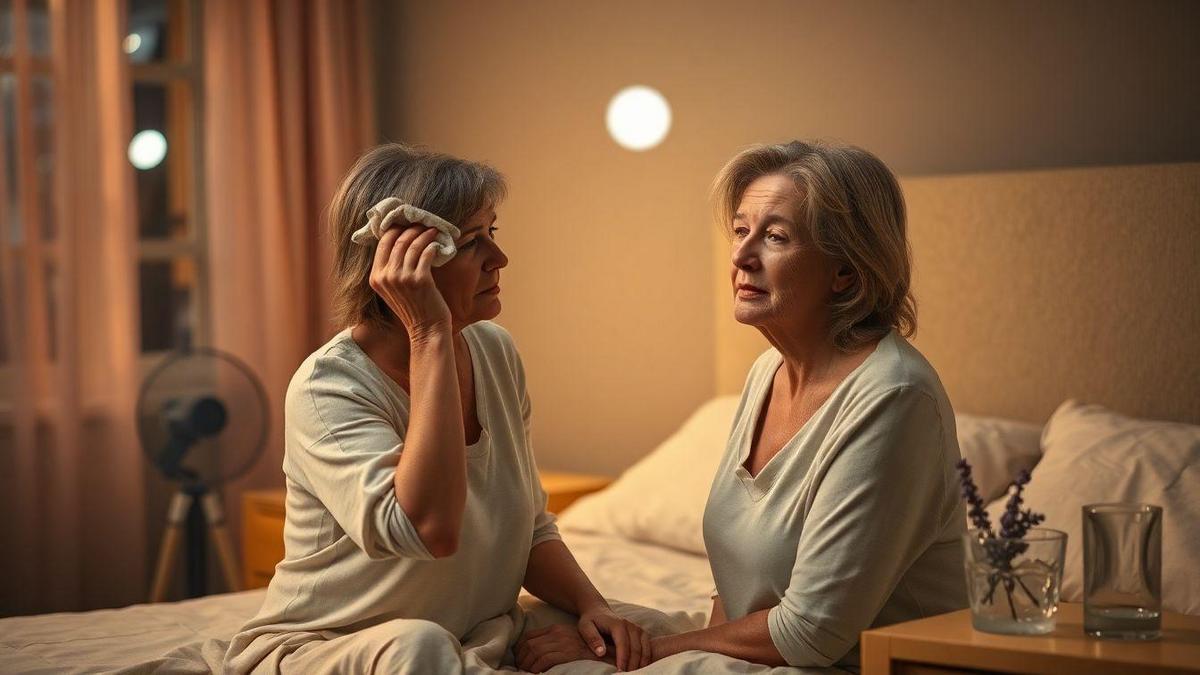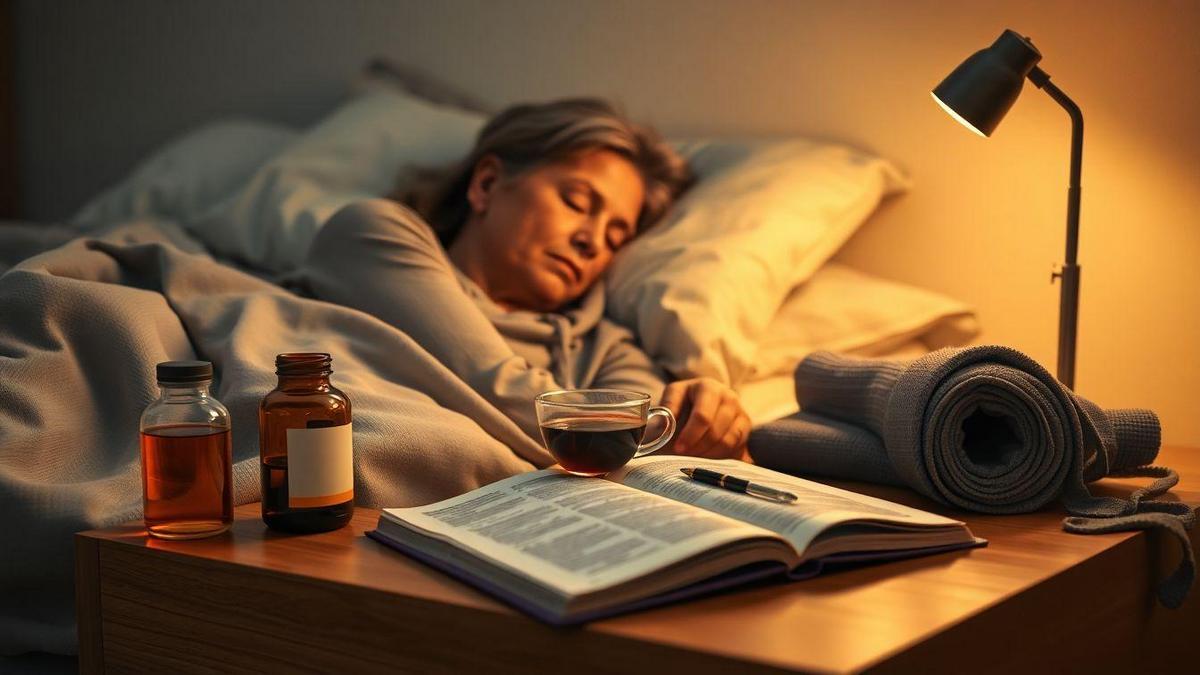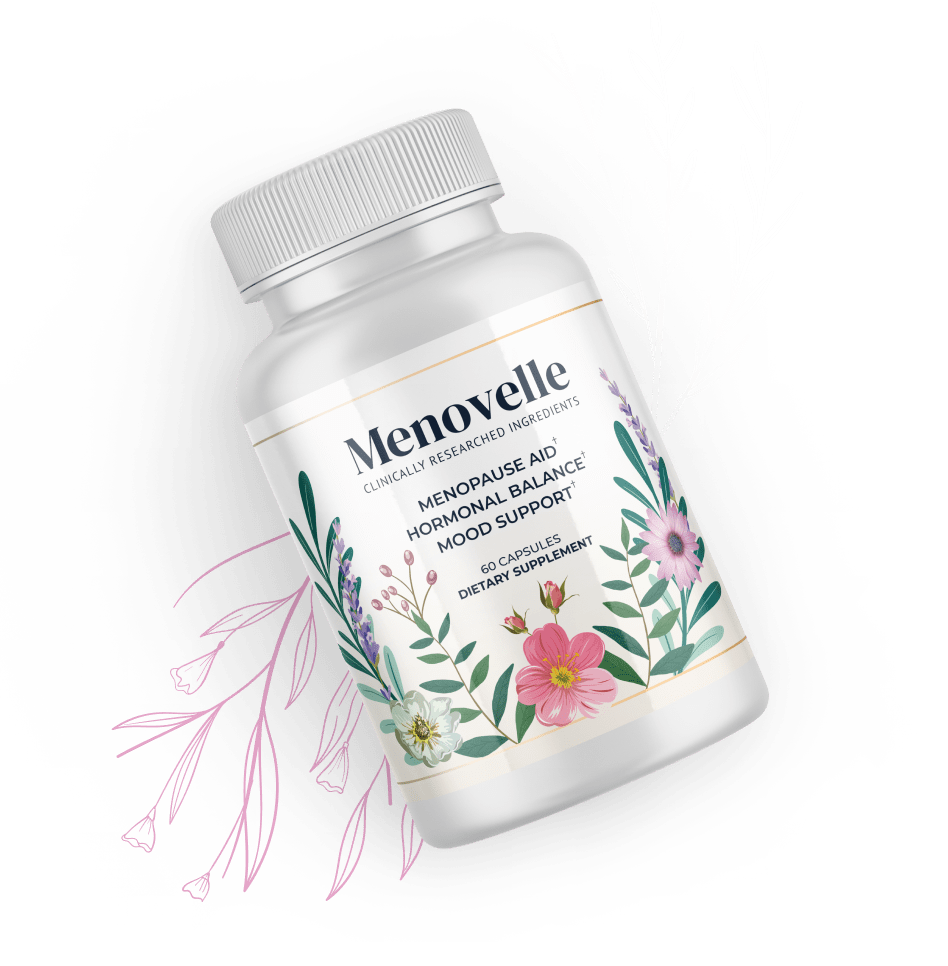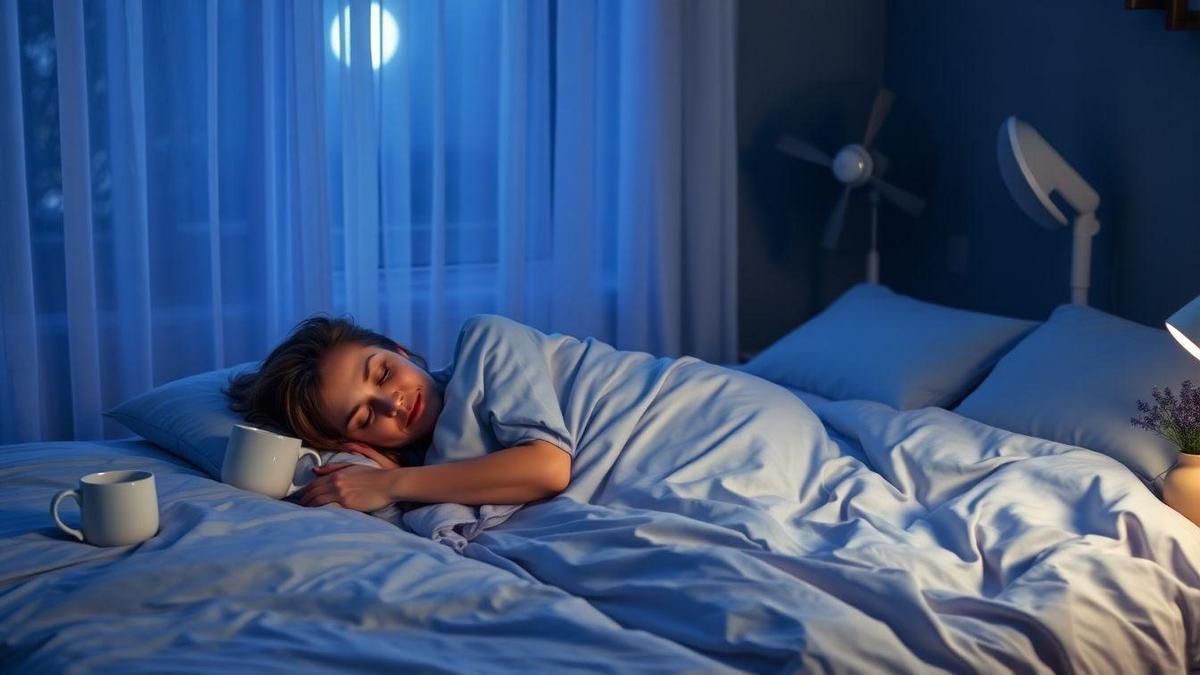Sleep Better During Menopause
Try these simple steps tonight to start sleeping better. You’ll get easy sleep hygiene tips—keep a regular bedtime, and make your bedroom cool, dark, and quiet. Limit screens and caffeine, choose breathable bedding and lightweight clothing, use cooling pads for night sweats, and time fluids. Learn when to talk to your doctor about hormone therapy, and try non‑drug tools like CBT‑i, melatonin, a smart diet, gentle exercise, plus quick relaxation moves (breathing, mindfulness, light stretches) to help you sleep. For broader menopause strategies, consider these menopause relief tips.

Key Takeaway
- Keep your bedroom cool and dark to ease night sweats.
- Go to bed and wake up at the same time each day.
- Avoid caffeine and alcohol late in the day.
- Do deep breaths or light stretches before bed to relax.
- Ask your doctor about treatments if you still can’t sleep.
Sleep Better During Menopause with Simple Sleep Hygiene
Sleep tips for menopause: regular bedtimes and a calm bedroom
Set a regular bedtime and wake time. Aim to go to bed and get up within the same 30 minutes every day—even on weekends. That steadiness restores sleep drive and reduces night wakings.
Make your bedroom a calm space: remove clutter, dim lights, and use soft sounds if needed. Think of your room as a small, steady cabin—when it’s calm you sleep better.
Simple bedtime routine (you can try tonight):
| Time before bed | Action | Why it helps |
|---|---|---|
| 60–90 min | Wind down: low light, quiet activity | Signals your body to relax |
| 30–60 min | Light stretch or breathing (5–10 min) | Lowers heart rate and stress |
| 0–15 min | Read, breathe, lights out | Easier to fall asleep |
Sleep hygiene for menopause: limit screens and caffeine
Cut screens at least 60 minutes before bed—blue light keeps the brain alert. If you must use a device, use night mode and lower brightness.
Stop caffeine at least 6 hours before bedtime. Avoid late alcohol—it may help you fall asleep but fragments sleep later.
What to cut and when:
| Item | Stop by |
|---|---|
| Caffeine (coffee, tea, cola) | 6 hours before bed |
| Nicotine | Several hours before bed |
| Screens (phone/tablet/TV) | 60 minutes before bed |
| Heavy meals | 2–3 hours before bed |
Cool, dark, quiet bedroom and breathable bedding for night sweats
Keep your room cool (about 60–67°F / 15–19°C). Use a fan or AC. Darkness signals sleep—blackout curtains help.
Choose breathable bedding (cotton, bamboo, linen) and thin layers so you can shed covers during a hot flash. A cold water spray or a small frozen gel pack near your feet can help you fall back asleep quickly.
Quick gear guide for night sweats:
| Problem | What to try |
|---|---|
| Too hot | Fan, lower thermostat to 60–67°F |
| Sweating sheets | Cotton or bamboo sheets |
| Night flash wakes you | Lightweight duvet top sheet (remove top layer) |
| Sudden heat | Small ice pack or cool spray nearby |

Manage Night Sweats and Hormones to Sleep Better During Menopause
Practical ways to reduce night sweats and hot flashes
Start by cooling your bedroom and cutting evening triggers: skip alcohol, caffeine, and spicy foods before bed. Move intense exercise earlier in the day—late workouts raise core temperature.
Use calming habits before sleep—deep breathing, short meditation, or gentle stretching—to reduce stress that can stoke night sweats. Keep a two‑week sleep log noting food, drink, and sweat timing; it helps spot patterns and gives your doctor useful data.
Small, steady changes work best—try a few adjustments and keep what helps.
Hormone therapy and sleep: when to talk to your doctor
Talk to your doctor if night sweats or hot flashes frequently wake you or impair daily life. Discuss hormone therapy (HT)—it can significantly reduce hot flashes and often improves sleep.
Bring a brief list: symptoms, medical history, and medications. Ask about risks and benefits. Options include low‑dose estrogen or non‑hormone treatments (some SSRIs, gabapentin) and lifestyle approaches. Plan a short trial, track sleep changes, and report side effects so your provider can adjust treatment.
Lightweight clothing, cooling pads, and timing fluids
Choose breathable fabrics (cotton, bamboo) and loose fits to aid airflow. Avoid heavy synthetics.
Cooling products—gel pads, phase‑change mattress toppers, chilled pillows—pull heat away. A fan aimed at your chest or feet cools quickly.
Hydration: drink enough during the day, cut back on evening alcohol, and limit big drinks before bed to reduce night bathroom trips. If you wake sweaty, sip cool water slowly.
Compare options:
| Item | What it does | Quick tip |
|---|---|---|
| Cotton or bamboo sleepwear | Lets air flow, wicks moisture | Wear loose fits |
| Cooling pad / gel topper | Absorbs heat from your body | Use on hot nights only |
| Fan | Moves cool air across skin | Aim at chest or feet |
| Timing fluids | Keeps hydration steady | Hydrate earlier; limit late drinks |
| Avoid triggers | Cuts night flash frequency | No spicy food, alcohol, or late caffeine |
These tools work best together—pick a few and use them consistently.

Use CBT, Melatonin, Diet and Exercise to Sleep Better During Menopause
Cognitive behavioral therapy for insomnia (CBT‑i)
CBT‑i addresses thoughts and habits that keep you awake. It treats root causes, not just symptoms. Typical parts: sleep restriction, stimulus control, sleep hygiene, and cognitive reframing.
- Sleep restriction: tighten time in bed so sleep deepens.
- Stimulus control: use bed only for sleep and sex to re‑train associations.
- Cognitive reframing: reduce worry and rumination.
CBT‑i often shows improvement in weeks. If hot flashes or anxiety wake you, CBT‑i can lower their sleep impact. Ask a sleep specialist or try a vetted online CBT‑i program listed on our resource page.
Key CBT‑i steps and quick actions:
| Component | What it does | Quick action |
|---|---|---|
| Sleep restriction | Increases sleep drive | Limit time in bed to actual sleep time |
| Stimulus control | Reduces wakeful associations | Use bed only for sleep and sex |
| Cognitive techniques | Calms racing thoughts | Write worries down earlier in the evening |
| Sleep hygiene | Builds healthy habits | Keep room cool, dark, and consistent schedule |
Diet, exercise, and melatonin
What you eat, how you move, and careful use of melatonin shape your nights.
Diet tips:
- Cut caffeine after midday; it lingers.
- Reduce alcohol at night; it fragments sleep.
- Eat balanced meals with protein and fiber to stabilize blood sugar.
- If you wake hungry, try a light snack with tryptophan (yogurt, banana).
- Consider gut‑supporting foods and probiotics to support digestion and overall comfort.
Exercise tips:
- Move daily—20–30 minutes helps mood and sleep.
- Prefer morning or afternoon workouts; intense evening exercise can keep you wired.
- Mix cardio, strength, and gentle movement (yoga) to support mood and bones. For cognitive symptoms like fog, some people explore targeted supplements such as creatine for brain fog or omega‑3s—see our overview of omega‑3 and brain health.
Melatonin:
- Melatonin can help reset sleep timing and shorten sleep onset.
- Use low doses about 30–60 minutes before bed.
- Check with your clinician if you take other medications or have health conditions.
Quick guide:
| Tool | Why it helps | Quick tip |
|---|---|---|
| Diet | Stabilizes sleep cues and hormones | Stop caffeine after midday; favor balanced meals |
| Exercise | Reduces anxiety and boosts sleep pressure | 20–30 min daily; do intense work earlier |
| Melatonin | Resets sleep timing | Low dose 30–60 min before bed; consult provider |
These steps work together—exercise raises sleep drive and a stable evening meal keeps blood sugar steady, helping you Sleep Better During Menopause. For product ideas, see our roundup of the best menopause supplements.
Try relaxation techniques: breathing, mindfulness, gentle stretches
Relaxation calms the nervous system so sleep can follow. Pick one or two and practice nightly.
- Box breathing: breathe in 4, hold 4, breathe out 4, hold 4. Repeat 4 times.
- Progressive muscle relax: tense a muscle for 5 seconds, then release from toes to head.
- Mindful breath check: notice your breath for one minute; guide it back gently when it wanders.
- Gentle stretches: neck rolls, seated forward fold, or child’s pose for 1–2 minutes each.
Relaxation moves and when to use them:
| Technique | How to do it | When to use |
|---|---|---|
| Box breathing | 4‑4‑4‑4 pattern | After getting into bed, when mind races |
| Progressive relax | Tense, release muscle groups | Before sleep or during night wakings |
| Gentle stretches | Slow, easy holds | 10–20 minutes before bed |
Use these consistently—over time your body will learn that bedtime means calm.
Quick Checklist to Sleep Better During Menopause
- Set a regular bedtime and wake time.
- Make the bedroom cool, dark, and quiet.
- Choose breathable bedding and lightweight clothing.
- Limit screens, caffeine, and alcohol in the evening.
- Use cooling aids for night sweats (fan, gel pad).
- Try CBT‑i, low‑dose melatonin, and regular exercise.
- Practice a short relaxation routine each night.
- Keep a sleep log and talk to your doctor about hormone therapy if sleep remains poor.
Conclusion
You can Sleep Better During Menopause by stacking simple, consistent habits: keep a regular bedtime, make your bedroom cool, dark, and quiet, choose breathable bedding and lightweight clothing to manage night sweats, limit screens, caffeine, and alcohol in the evening, and use quick calming tools—box breathing, gentle stretches, or progressive relaxation. Consider CBT‑i, low‑dose melatonin for timing, and discuss hormone therapy with your doctor if symptoms disrupt life.
Think of this as a toolbox: mix a few practical steps nightly and tweak until the signal is clear. Small, steady changes add up fast.
Want more practical tips and product guides to help you sleep? Explore our Supplement Hive blog for guides and reviews.
Learn more: Menovelle review — a clear look at a natural option for hot flashes, mood and weight





